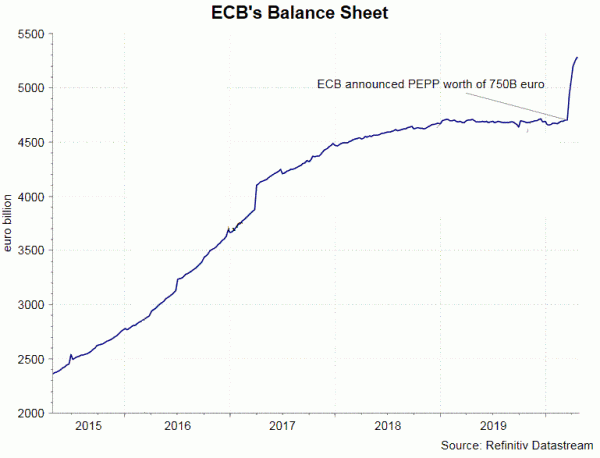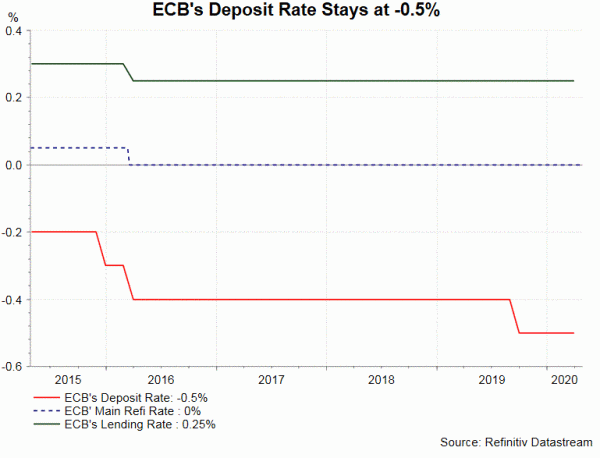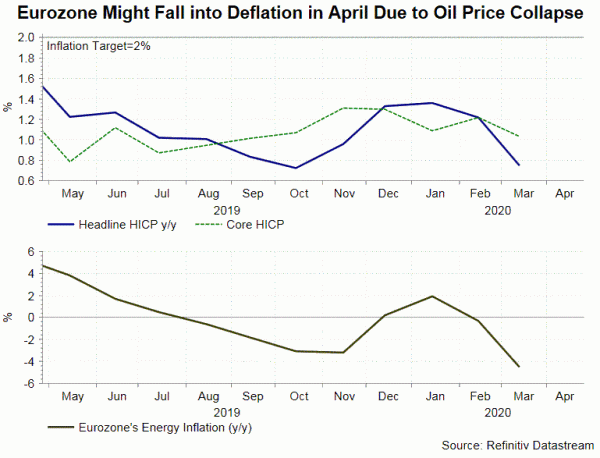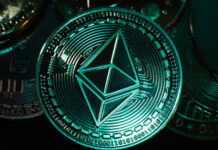We expect ECB to keep its powder dry at this week’s meeting, after launching several stimulus measures last month. The central bank should maintain a dovish tone, indicating disappointing economic data and pledging the take further actions if needed. As EU has so far failed to agree on substantial fiscal actions, we expect ECB will in coming months step up its QE measures. Extension of PEPP would be a likely move.
At the regular meeting on March 12 and telephone conference on March 18, ECB announced a number of measures with the aim of containing the sharp deterioration in economic activities due to the coronavirus outbreak. At the March meeting, ECB left the deposit rate unchanged at -0.5% but introduced an envelope to buy up to 120B euro in the Asset Purchase Program (APP) until the end of the year. Moreover, the central bank launched new LTROs until June 2020 to fund banks’ liquidity needs. It also improved TLTRO-III by relaxing loan eligibility and increasing incentive rate, effective June 2020. At the telephone conference on March 18, ECB adjusted collateral standards for ECB’s repo operations, allowing banks to use loans to the corporate sector as collateral for TLTRO funding. Meanwhile, the central bank launched a Corporate Sector Purchase Program (CSPP), making all commercial papers of sufficient credit quality eligible for the program. ECB went further as it announced a 750B euro Pandemic Emergency Purchase Programme (PEPP) to buy private and public sector securities. Intended to be in place through 2020 or longer if need, PEPP could bring ECB’s purchases to 1 trillion euro. The central bank announced to remove its 33% issuer supply constraint for PEPP on March 26.
 On the fiscal front, the Eurogroup agreed on a joint stimulus package earlier this month. Support to mitigate Unemployment Risks in an Emergency (SURE), a funding scheme worth of 100B euro, aims at helping member states protect jobs and thus employees and self-employed against the risk of unemployment and loss of income. It will be funded via bond issuance with 25B euro guarantees to be raised by member states. Meanwhile, the Board of Directors of the European Investment Bank (EIB) will support creation of a European COVID-19 guarantee fund worth of 25B euro. The fund will enable the EIB group to scale up its support for European companies (mainly SMEs)up to an additional 200B euro. Worth of 240B euro, the ESM allows “Pandemic Crisis Support” credit line for up to 2% of each country’s GDP. Meanwhile, the European Commission has temporarily lifted the rule that deficit of a member state has to be 3% of GDP of below. Despite all these, the member states have still failed to agree on the details of the recovery fund. It is expected that the fund will be worth of a trillion, aiming at fueling economic recovery of member states once the lockdown is over.
On the fiscal front, the Eurogroup agreed on a joint stimulus package earlier this month. Support to mitigate Unemployment Risks in an Emergency (SURE), a funding scheme worth of 100B euro, aims at helping member states protect jobs and thus employees and self-employed against the risk of unemployment and loss of income. It will be funded via bond issuance with 25B euro guarantees to be raised by member states. Meanwhile, the Board of Directors of the European Investment Bank (EIB) will support creation of a European COVID-19 guarantee fund worth of 25B euro. The fund will enable the EIB group to scale up its support for European companies (mainly SMEs)up to an additional 200B euro. Worth of 240B euro, the ESM allows “Pandemic Crisis Support” credit line for up to 2% of each country’s GDP. Meanwhile, the European Commission has temporarily lifted the rule that deficit of a member state has to be 3% of GDP of below. Despite all these, the member states have still failed to agree on the details of the recovery fund. It is expected that the fund will be worth of a trillion, aiming at fueling economic recovery of member states once the lockdown is over.
Economic data released since ECB’s telephone conference suggest that risks are skewed to the downside on Eurozone’s outlook. Final HICP indicate subdued inflation in March. Both headline and core HICP stayed unrevised at +0.7% y/y and +1.2% y/y, respectively. Notwithstanding the fact that the bloc’s inflation has been staying far below ECB’s target of +2%, the reading in March did not take into account the collapse of oil price in April. We are concerned that oil price and the pandemic-linked demand destruction could lead the Eurozone to deflation in April. Concerning the leading indicators for April, the flash Markit composite PMI slumped to 13.5 in April from 29.7 a month ago. The market had anticipated a milder drop to 25.7. A reading below 50 signals contraction which was seen in both manufacturing and services sectors. Consumer confidence index worsened to -22.7 in April from -11.6 in the prior month.
Against the backdrop of insufficient fiscal support and fragile economic developments, ECB is obliged to take further actions to stimulate growth. Yet, it does not necessarily happen at regular meetings. At the upcoming meeting, it is possible that the members will evaluate the measures announced in March and gauge the initial influence on the economy.We see the potential for ECB to accelerate buying in PEPP before new policies are announced. The program has an overall envelope of 750B euro or about 94B euro/month. Over the past 4 months since the programme has been launched, ECB has purchased about 96.7B. We believe it is prudent to front-load the purchases as economy is the most severely hurt in 1Q20 and 2Q20.
Policymakers will likely discuss at the upcoming meeting further actions to take if needed. Regarding further measures to implement, we expect rate cut is the least likely. Leaving the deposit rate unchanged in March has already demonstrated that many members are reluctant to lower the policy rate further. On QE, we believe scaling up PEPP is more flexible than APP. PEPP is created in light of the coronavirus outbreak and has a definite end-date (temporary in nature). It is easier to manage if ECB decides to increase the size of PEPP and/or announce that it will be extended to say end 2021. On the other hand, APP has been in place since 2014 to support the monetary policy transmission mechanism and provide the amount of policy accommodation needed to ensure price stability. It will likely continue running after the current pandemic.













